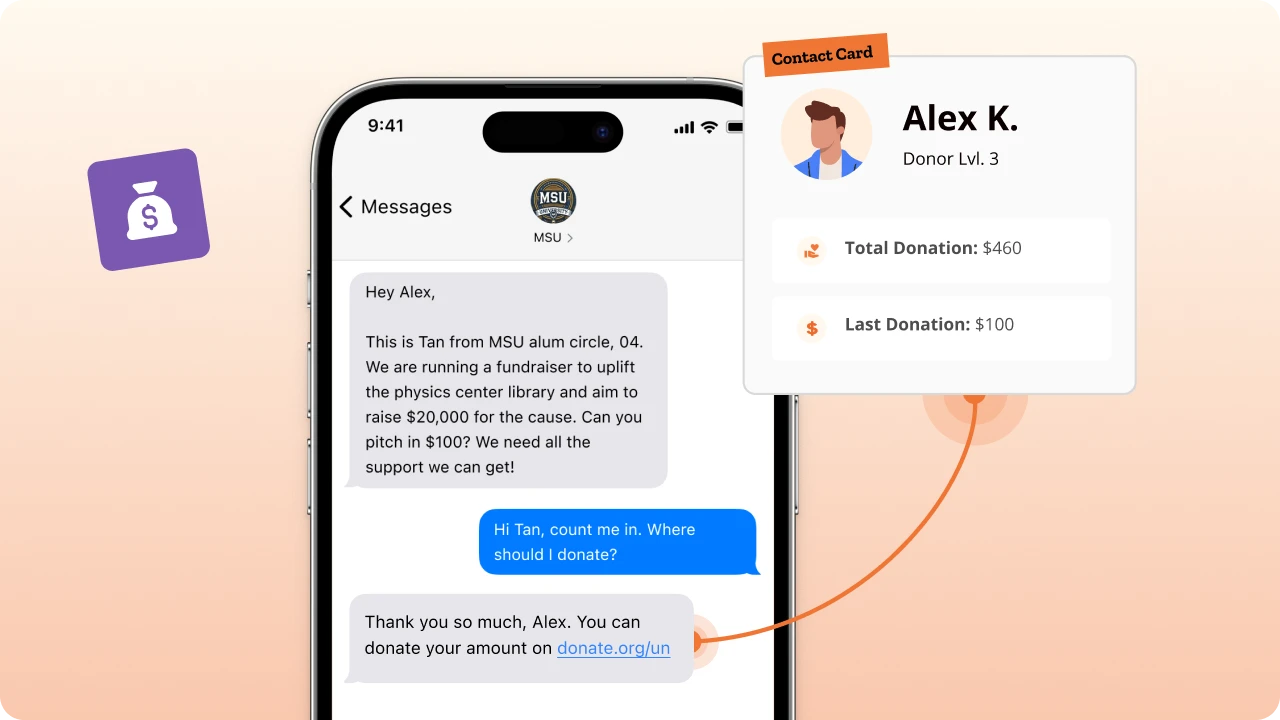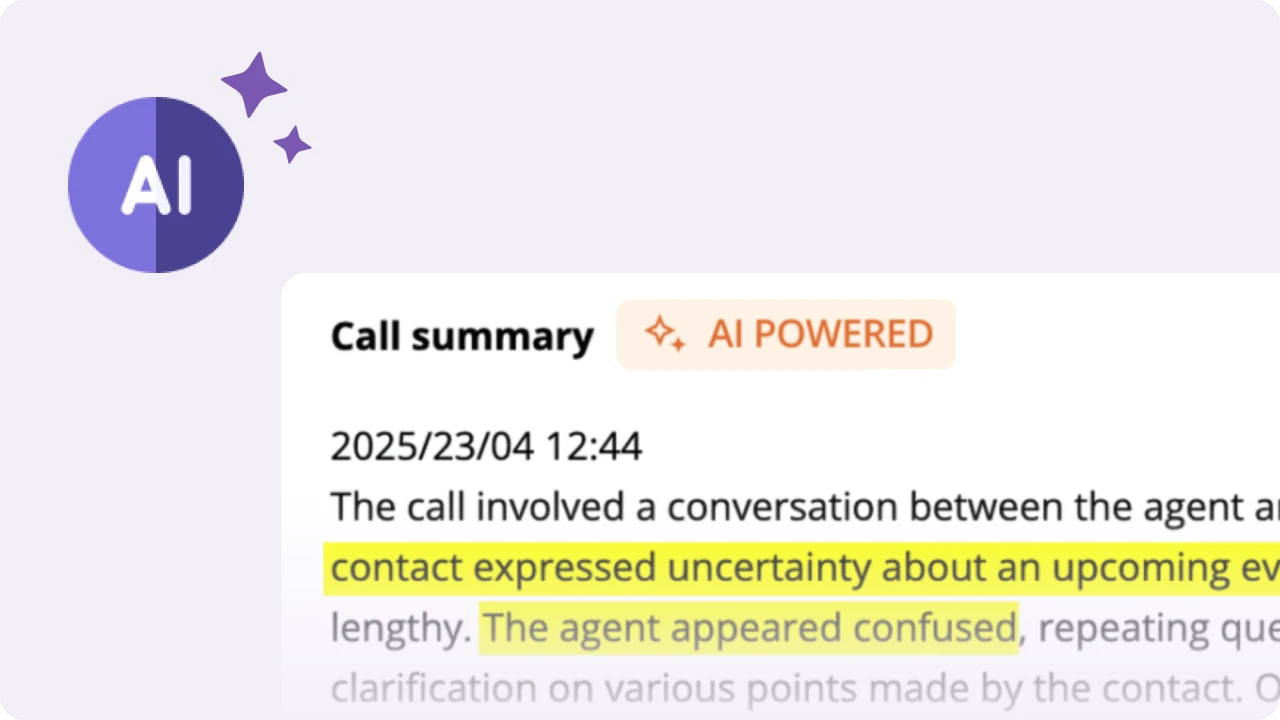Table of Contents
Texting donor retention is quickly becoming one of the best ways for donor retention and engagement among CallHub customers. Here are some key numbers every CallHub user should know:
- Mobile giving donations increased by 205% in one year
- 4.5% of online donations came through texting.
- Nonprofits sent an average of 46 texts a year
- The average donation amount for text-to-donate campaigns is $107.
We highly recommend that texting campaigns be a regular feature of your outreach program, as one of your core fundraising strategies.
What do we mean? You shouldn’t use CallHub’s text broadcast system to send reminder texts only for events or big days. Use it to engage regularly with donors across a variety of situations.
So let’s get into some of the best ways to use text to keep your donor engagement high. But before we kickstart that, let’s talk about two choices: the format your message will be composed in and the method you choose to broadcast it.
Let’s start with message formats.
Message formats
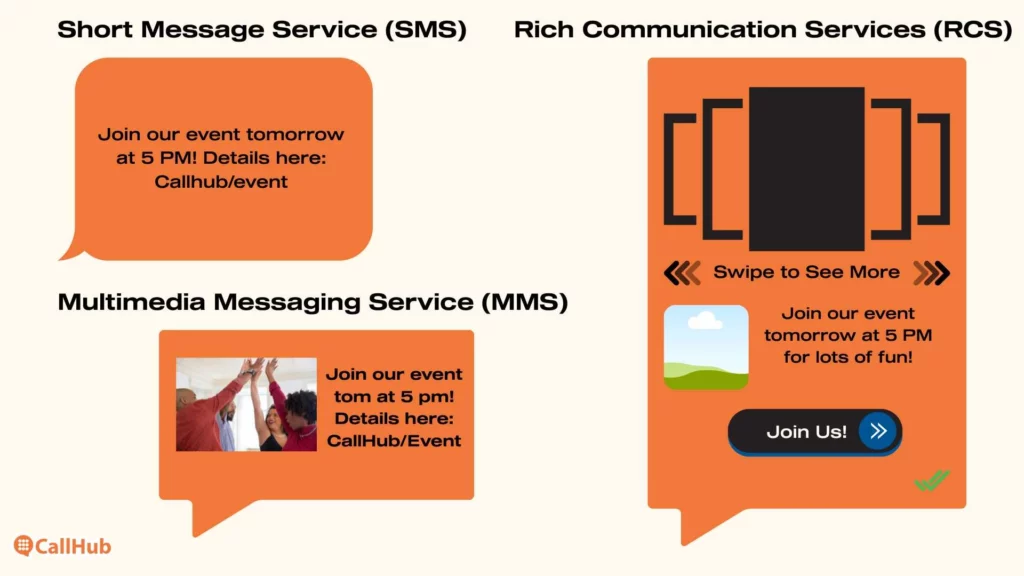
SMS, MMS, and RCS are three primary formats through which you can send your messages.
- An SMS is text-only, cost-effective, and universally accessible. Suitable for notifications, reminders, and time-sensitive appeals.
- An MMS lets you add multimedia content like a picture or video, but is sent like an SMS. Suitable for visual storytelling and event promotions.
- RCS is highly interactive (For example, you can add clickable buttons) and is sent over the internet. Suitable for high engagement moments, like fundraising or impact stories.
The choice depends on whether your nonprofit campaign prioritizes reach, engagement, or advanced features.
Here’s a look at their features at a glance, to help you decide which one your message should go out in.
| Feature | SMS | MMS | RCS |
| Message Type | Text-only. 160 characters max per message. | Text with multimedia (images, videos, audio). | Rich media with interactive features (buttons, carousels) |
| Reach | Universal (all phones and carriers). | Broad (most phones and carriers). | Limited (modern smartphones with carrier support required) |
| Features | None. Delivery status only. | Basic. Multimedia support with images, HD video, GIFs. Metabase analytics are provided by CallHub. | Advanced. This includes read receipts, typing indicators, read rates, interaction tracking, and branded profiles. |
| Cost | Low. | Low. But higher than SMS. | Free to send in CallHub (limited time offer!). |
In short, if you want to send an urgent appeal to many people in a short period, with a limited budget, go for SMS. But if you have some time (both for the messages to be delivered and for you to craft them), go for RCS since it will have the most visual impact. MMS for delivering a large number of video, picture, or audio messages.
Important! Even if you send RCS, you will still have to make an SMS version of the message. Since RCS is not universally available on all mobile devices, the SMS will be sent where RCS is not possible. And you will be charged for those SMS.
Broadcast method: Text broadcast vs P2P
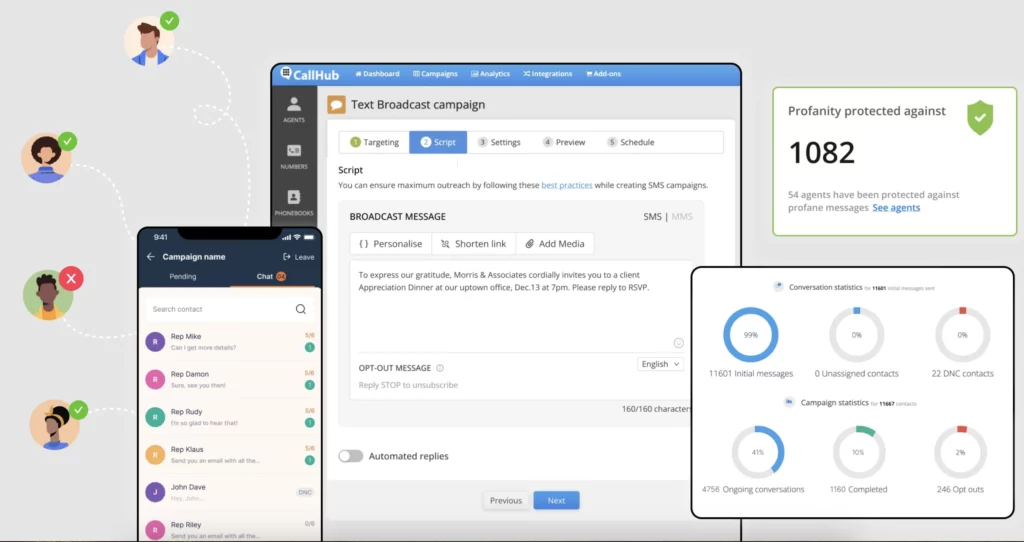
You can use CallHub’s texting services in many imaginative ways. You can send voice notes, automated replies to RSVP, reminder texts for events, surveys, videos, audio, carousels, etc.
But these are the formats of the message. What choices do you have regarding how to broadcast your message?
You have two.
One is to send it to everyone at once in a one-sided way (with automated responses for any replies you get.) This is the ‘Text Broadcast’ campaign in CallHub.
Launch campaign: How to set up a Text Broadcasting Campaign
The second is to send a first message to everyone, but then assign staff to reply individually to all those who reply, engaging them in some conversation. This is the ‘Peer-to-Peer’ campaign in CallHub.
Launch campaign: How to set up a Peer to Peer Texting campaign
You can pick your broadcast method depending on the context of each campaign you want to send out. Here’s a look at the features at a glance to help you make your choice.
| Feature | Text Broadcast | Peer-to-Peer Texting |
| Communication Type | One-to-Many: A single message is sent to multiple recipients simultaneously. | One-to-One: Messages can be sent in batches, but they still have to be be crafted one-by-one for a conversation. |
| Personalization | Limited: The same message is sent to all recipients, with some customization like first name, using ‘merge tags’.. | High: Replies can be customized for each recipient. |
| Interactivity | Minimal: No real-time interaction or two-way conversation. | High: Allows for real-time, two-way conversations. |
| Scalability | Highly scalable: Can reach thousands or millions of recipients instantly. | Scalable with fast P2P, but still significantly slower and smaller in scope than. |
| Cost | Cost-effective for large-scale campaigns (e.g., $0.01–$0.02 per SMS). | More expensive due to associated costs – like staff, hardware, rental space, etc. |
| Automation | Fully automated with scheduling and workflow tools. | The initial message can be automated, but ultimately requires manual effort. |
| Engagement | Minimal: Messages are sent in bulk with a single action. | High: Significant time is spent responding to individual messages. |
Now that you have selected the format for your messages, and the broadcast method of the campaigns you want to run (depending on your budget and scope), let’s get into the kind of campaigns you should be running to boost donor retention.
Types of texting campaigns for donor retention and engagement
Once someone has made a donation to you, you must run the campaigns we have suggested below to keep yourself in their social and charitable circle. We have consistently noted that sending regular engagement texts to donors leads to higher donations overall.
The logic is simple and human – you are more likely to help those you see as your regular friend, as opposed to someone you barely remember.
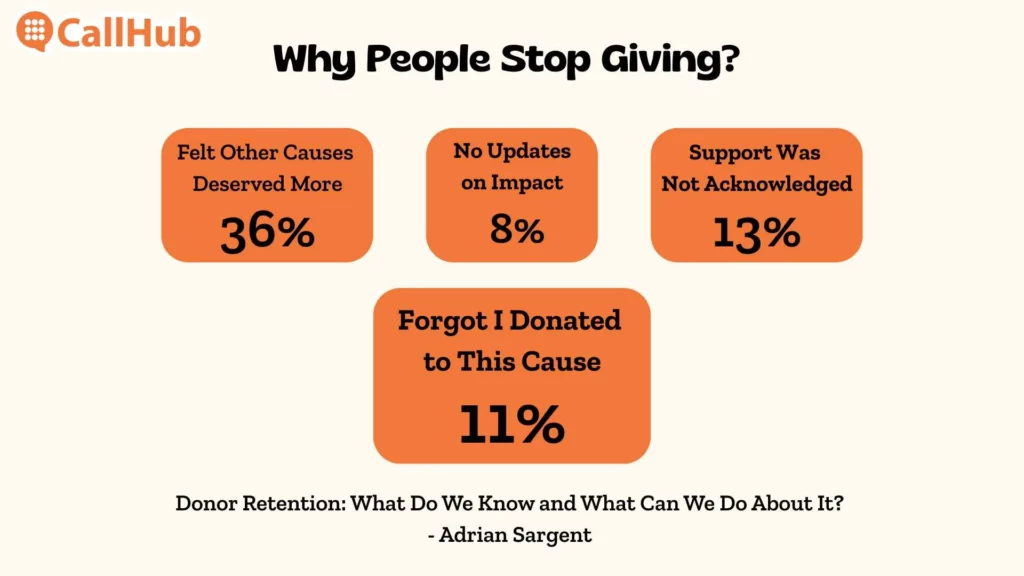
So let’s look at some campaigns, their effectiveness, and the CallHub tools you can use to run them.
Impact messages
Sending a simple ‘thank you’ after receiving a donation boosts future donations. This is a proven phenomenon confirmed by many studies, like this one, which proved – “Thank-You feedback from fundraisers can significantly decrease donor attrition rate.”
Up the game by sending the impact their donation is making in the same message, and make it personal by personalizing your message to cement your place in a donor’s mind. So make sure you are regularly sending out texts for all donations received in a certain time period.
For example, “Thanks to your support, Dave! We’ve provided clean water to 500 families this month and you’re making a real difference—thank you!”
| Sending impact and thank you messages through CallHub |
| Create a new contact list of donors within a certain time period (weekly or monthly) Create a new Text Broadcast campaign, and add your message Personalize the message using our ‘Merge tags’ Launch the campaign (and repeat this regularly) |
Recurring donation reminders
Recurring donors are really the gold standard for nonprofits, since it gives you an assured revenue stream. This helps nonprofits make long-term plans.
You must keep track of your donors, and ask them regularly if they would like to convert their donation into a ‘subscription’ for your nonprofit. (Yes, we can all learn from Netflix).
As mentioned in the steps above, create a new contact list of new donors, create a text broadcast campaign, and personalize it.
Example: “Join our monthly giving program and help us create lasting change! Click here to set it up in seconds: [link].”
| How to ask for recurring donations for a nonprofit |
| Recurring Donations: The Secret to Nonprofit Growth in 2025 Monthly Giving Program: How to Launch a Remarkable One |
Time-sensitive appeals
Use texts for urgent or deadline-driven campaigns, such as Giving Tuesday or emergency relief efforts. SMS or texts to donor phones are seen quickly and have a good conversion rate. Highlight the immediacy of the need and make donating easy with a direct link.
Example: “Only 24 hours left to meet our goal! Every gift today will be matched. Donate now: [link].”
So use text broadcasts to send out thousands of appeals immediately to your contact lists, who have opted in for communication from you via texts, known as the ‘text to donate’ system.
Set up a campaign now: Text to Donate: Best Ways to Get Funds & Donors Instantly
Also, through CallHub, you can ensure your message goes out as quickly as possible by using a 10 DLC verified number.
For example, through the carrier AT&T, campaigns with high vetting scores can achieve up to 4,500 messages every minute for SMS and 2,400 for MMS.
| Registering your number for 10 DLC for donation campaigns |
| Registering 10DLC with CallHub – Step by Step Use Case: How to Register my Campaign for 10DLC? 10DLC Compliance Made Simple: What’s New and What’s Next |
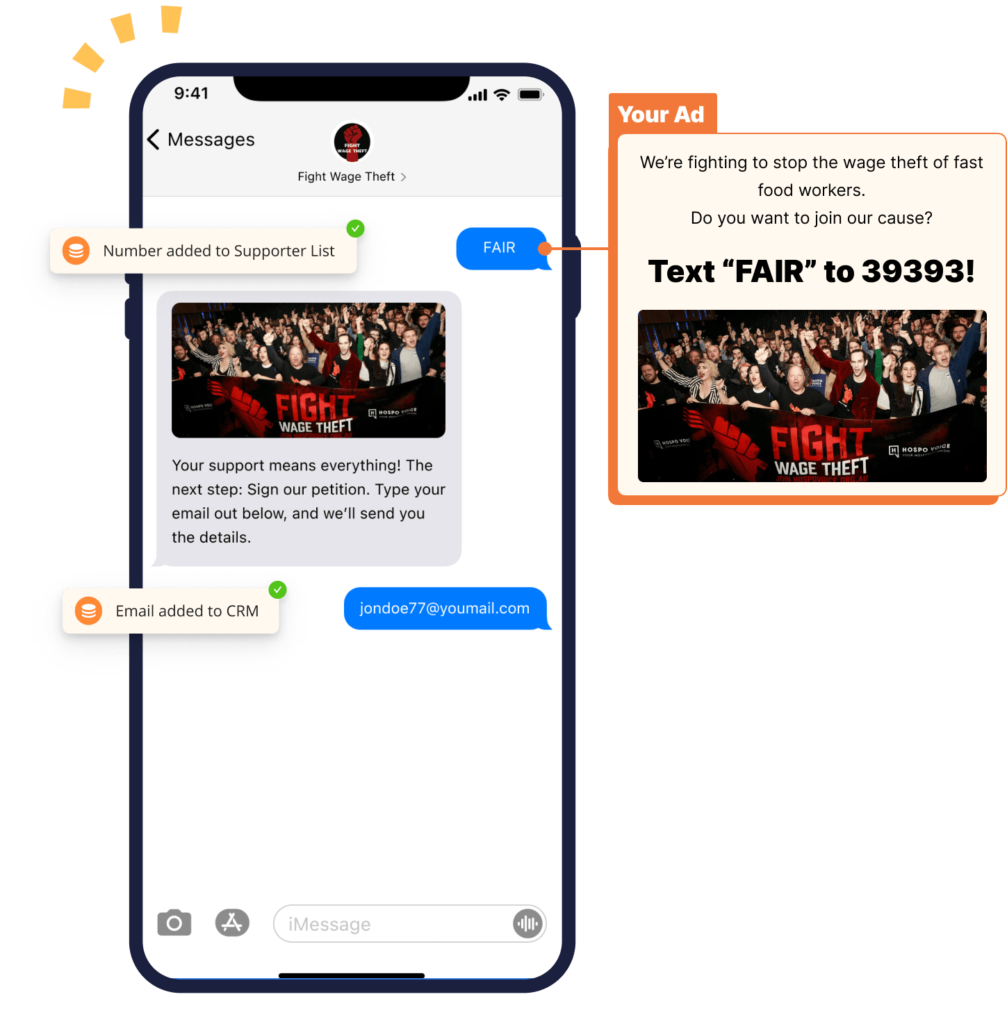
Event invitations & RSVP
Keep donors engaged by inviting them to events like fundraisers, webinars, or volunteer activities. More crucially, we will provide them with reminders and updates via texts to ensure participation.
For example: “You’re invited! Join us for our Annual Gala on May 15th. RSVP here: [link].”
And the follow-up – “Thanks for joining our Annual Gala. Just 4 days to go! [link]”
Now for reminders and RSVP, keep two things in mind:
- Set up your contact list to sync with your CRM, so donors who have signed up can be added to a new contact list.
CallHub automation with Workflows
- Set up an automated reminder flow using CallHub’s Workflows, so you don’t forget to send out texts in the correct order.
For example, once set up – if a donor replies with “yes” to an invite, then CallHub makes sure that the RSVP is tagged against their contact details in your CRM, adds their name to a new contact list using Workflows, and you can schedule a texting campaign to that contact list well in advance.
Launch a campaign: Learn how to automate your texting campaigns on Callhub
Peer-to-Peer texting campaigns
Leverage CallHub’s Peer-to-Peer texting system for personalized outreach, where volunteers or staff speak to donors directly. This sort of campaign should be regularly run beyond the text broadcast ones.
Why? To speak to a donor, one-on-one. You can ask for feedback about your programs, personally thank large donors, and share impact stories in a personal capacity.
Example: “Hi [Name], this is [Volunteer Name] with [Nonprofit]. Just wanted to thank you for your support and share how your gift helped us achieve [specific result]. Can we speak for a few moments?”
| How to run a Peer-to-Peer campaign on CallHub |
| Create a Peer-to-Peer campaign. Add agents you trust to have these chats to the campaign. Create message templates for the most common answers or messages to be given to all donors, which your agents can just select in their console. Launch the campaign with a common opening message to all donors. Encourage agents to speak to donors after the standard messages have been sent. |
Read More: 13 Best Practices you must follow for Peer-to-Peer Texting
Between regular text broadcasts and in-depth P2P conversations, your donors should feel they are well-engaged by you meaningfully. This is critical. Make sure discussions (and updates) have some value to a donor.
It takes a donor only a minute to block a number, which annoys them. But that block could be hundreds of dollars in lost donations every year. So, plan your donor conversations well.
Read More: Tones, Questions & Responses: We Analyzed 400+ P2P Texts to See How They Begin
| Metrics for donor retention and engagement |
| Open rates: Measure the percentage of recipients who open the messages. Response rates: Evaluate the proportion of recipients who reply or take action. Click-through rates (CTR): Monitor the percentage of recipients who click on embedded links. Conversion rates: Assess the number of recipients who complete the desired action, such as donating. Opt-Out rates: Track the number of recipients who unsubscribe from future messages. |
Hopefully, you have understood the importance of running text campaigns and have considered the resources we have shared with you on setting up and launching your campaigns.
Retention may be a small part of your efforts compared to finding new donors in exciting new plans. But remember – a donor retained is always more likely to donate again than a new donor.
So why wait? Get started now!

